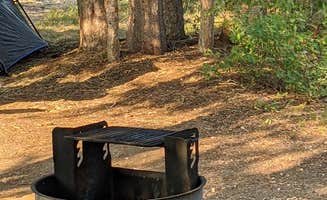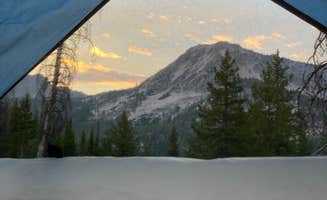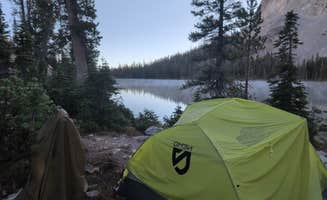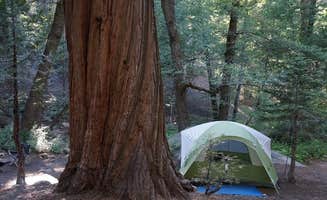Dispersed camping near Lowman, Idaho provides access to over 2.5 million acres of Boise National Forest wilderness. The area sits at elevations ranging from 3,900 to 5,200 feet, creating distinct camping conditions that vary significantly between seasons. Winter snow accumulation often exceeds 6 feet at higher elevations, while summer daytime temperatures typically reach 75-85°F with nighttime lows dropping to 40-50°F even in July.
What to do
Fly fishing opportunities: South Fork Recreation Site offers direct access to premium fishing waters. "Beautiful place to boondock overlooking the river. Great scenery. Many trails around both for hiking and four wheeling," notes Mike E., though he cautions about noise from a nearby shooting range.
Hot spring exploration: The campgrounds near Hot Springs Campground provide access to natural thermal pools. The area features several undeveloped hot springs accessible via short hikes from established campsites, with water temperatures ranging from 95-110°F depending on the spring and season.
Mountain summit hikes: Bald Mountain Campground serves as a base for lookout hikes. "It's about 30 min above the highway so a bit far. Close to the bald mtn lookout," explains Dominik S. The trail to the fire lookout gains approximately 800 feet of elevation over 1.2 miles, offering 360-degree views of the surrounding mountain ranges.
What campers like
Creek-side sites: Bench Creek Campground features select sites backing directly to water. "Sites 2, 3, and 4 back up nicely to the creek," reports Annie C., adding "Vault toilet but no water or trash, so pack in pack out."
Shade coverage: Many sites throughout the forest provide natural protection from summer heat. Zach P. notes that Bench Creek offers "clean sites and nicely paved" areas with connectivity options: "Got starlink but no Verizon service."
Peaceful atmosphere: Whoop-em-up Equestrian Campground offers quieter experiences away from busier areas. "Quiet with restroom and clean water. Lots of firewood laying around. No cell service, except Mores Peak and Idaho City... But overall an awesome 2 days of peace and quiet and no cell," shares Michelle P., noting she "heard running water in the distance."
What you should know
Cell service limitations: Most campgrounds have minimal to no connectivity. "No service in Lowman (only 1 mercantile with 2 pumps), but an absolutely gorgeous drive," reports Michelle P. about Whoop-em-up Equestrian Campground, echoing conditions throughout the region.
Road conditions: Access to several campgrounds requires navigating steep, winding roads. Mike E. explains about Edna Creek: "The last 20 or 30 minutes Beyond Idaho City going east is a pretty steep Winding Road and a little bit narrow. The longer your trailer and rig the more skill you will need to climb this route."
Fire restrictions: Seasonal bans often begin in mid-June and extend through September. Jonathan A. notes that "the forest rangers like to come out and make sure you dont have a campfire" in many dispersed areas during high-risk periods.
Tips for camping with families
Beginner-friendly sites: Edna Creek offers approachable terrain for first-time campers. Amy S. explains it "is more geared toward tent camping. There is limited space for larger RVs. There are no RV type amenities. Just vault toilets, picnic tables and campfire rings."
Wildlife awareness: Prepare children for encounters with small forest animals. Jonathan A. observes, "the chipmunks like to tease dogs" at South Fork Recreation Site, where various small mammals frequently visit campsites.
Water safety: Supervise children near creeks and rivers as water levels fluctuate seasonally. "The water is unbelievably clear, albeit 40ft down from the camp sites in most areas," notes Jonathan A., indicating steep dropoffs that require caution with young campers.
Tips from RVers
Size restrictions: Most campgrounds near Lowman accommodate smaller trailers only. Mike E. cautions about Edna Creek: "Definitely not for a large or long rigs" and describes how "you'll need to maneuver tightly in a few of the corners" due to the campground's compact layout.
Elevation considerations: Higher elevation campgrounds require engine preparation. Warm Springs Campground sits at a more accessible elevation, with K D. noting, "Because it was so dusty, we decided to stay in our car rather than pitching the tent," highlighting how weather conditions can influence accommodation choices.
Alternative parking options: When traditional sites are full, dispersed camping provides flexibility. Adam H. explains that near Warm Springs, "Campsites are all along a well-traveled forest road. If you don't mind the occasional car driving by at night, it is a good spot to spend the night on the way to or from the SNRA."







